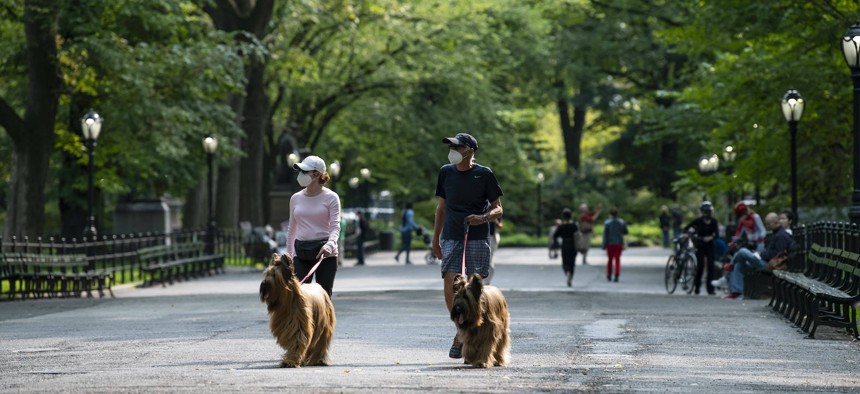On Monday, the U.S. Department of Justice classified New York City, along with Seattle and Portland, Oregon, as “anarchist jurisdictions.”
While many initially found this news humorous, sharing placid photos from around the city online, the new classification could have serious negative impacts on the city, especially when it comes to receiving federal aid.
The DOJ justified the city’s new classification by citing the increase in gun violence, budget cuts to its police department and several district attorneys in the city refusing to prosecute protest-related charges. City & State answered some of your biggest questions regarding the city’s new designation and what this may mean for its future.
What is the definition of an “anarchist jurisdiction”?
An “anarchist jurisdiction,” according to the DOJ, is a subdivision, like a city, that has “permitted violence and destruction of property to persist and (has) refused to undertake reasonable measures to counteract criminal activities.” President Donald Trump directed U.S. Attorney General William Barr and the DOJ to identify anarchist jurisdictions in a Sept. 2 memorandum.
Why was NYC classified as an anarchist jurisdiction?
New York City saw a rise in shootings and murders over the summer. From Jan. 1 through Sept. 13, the city had 321 murders, compared with 230 at this time last year. Due to heightened concerns over police violence against Black people, the New York City Council, in collaboration with Mayor Bill de Blasio, cut $1 billion from the NYPD’s budget. The DOJ said the cuts will remove essential police functions, which it said was a reason to classify New York City as anarchistic. But the reality of the budget cuts was slightly more complicated. The department’s overtime budget was supposed to decline by $335 million, but the Independent Budget Office found that was unlikely to happen due, in part, to the recent protests against police brutality and systemic racism. Also, school safety agents and crossing guards were supposed to be moved out of the NYPD, but that hasn’t happened yet. Another reason cited by the DOJ for New York City’s classification was the refusal by Manhattan District Attorney Cyrus Vance Jr. and Queens District Attorney Melinda Katz to prosecute Black Lives Matter protest-related charges. Plus, de Blasio and Gov. Andrew Cuomo refused federal military support from Trump during the protests.
How could this affect the city’s federal funding?
The new classification could prevent the city from receiving federal funding, according to Barr, who had threatened to do so if violent demonstrations did not stop. “We cannot allow federal tax dollars to be wasted when the safety of the citizenry hangs in the balance,” Barr said. “It is my hope that the cities identified by the Department of Justice today will reverse course and become serious about performing the basic function of government and start protecting their own citizens.” Barr also cited the Trump memorandum, which noted that the director of the Office of Management of Budget “shall issue guidance to the heads of agencies on restricting eligibility” of federal funds, as much as the law permits. In June, prior to the memorandum, Republican senators introduced a bill called the Ending Taxpayer Funding of Anarchy Act, which proposed the ineligibility of “federal financial assistance” to cities defined as an anarchist jurisdictions, beginning in the 2021 fiscal year.
What’s at stake if the city loses federal aid?
According to a preliminary analysis by New York City Comptroller Scott Stringer’s office in 2016, the city received less than 9% of its budget from the federal government. However, that federal money did make up a sizable portion of the budgets for some city agencies, such as the Department of Housing Preservation and Development and the Administration for Children’s Services.If the cuts hit those agencies, it would place city programs in a dangerous position. The coronavirus has wreaked havoc on the finances of state and local governments, with a $14.5 billion state budget gap projected for the current fiscal year. The state is waiting on additional federal aid from Congress, so a drop in federal aid to the city could be another significant setback.
Is there anything the city or state can do to stop this?
Gov. Andrew Cuomo and state Attorney General Letitia James threatened to sue the DOJ over the city’s new classification. Cuomo cited the 10th Amendment, which guarantees states’ rights, as an assurance that states and citizens have the control over that funding, not the president or attorney general. “The president should be prepared to defend this illegal order in court, which hypocritically lays the groundwork to defund New York and the very types of law enforcement President Trump pretends to care about,” James said.
Is this part of Trump’s reelection strategy?
Cuomo said the move to label cities as “anarchist jurisdictions” was made so that Trump could establish himself as the “law and order” candidate in the upcoming election. Trump has been similarly threatening to cut federal funding for “sanctuary cities” since 2017, but has yet to follow through due to a lengthy legal battle. So it’s entirely possible that this is another empty threat by the president.

NEXT STORY: New furloughs empower New York City unions


